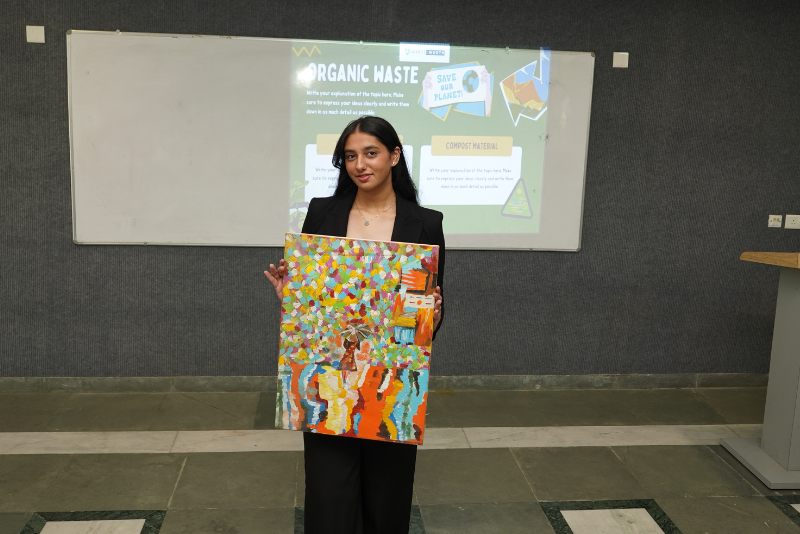
The world of art is brimming with vibrant colors, captivating textures, and endless possibilities for expression. Traditionally, canvases and paints have been the foundation for artistic creation. But what if we looked beyond the store-bought supplies and unearthed artistic potential in the very “waste” we discard?
Transforming waste into art is not just innovative; it’s a powerful statement on sustainability and resourcefulness. It allows us to breathe new life into discarded materials, reduce our environmental footprint, and create unique, thought-provoking pieces. So, grab your creativity and delve into the world of recycled art!
Unveiling Your Recycled Canvas
The beauty of recycled art lies in the endless possibilities for your canvas. Here are some unique options to explore:
Cardboard Canvas: Cardboard is a readily available and sturdy base. Flatten boxes of various sizes and thicknesses to create a multi-dimensional piece.
Fabric Scraps: Upcycle leftover fabric scraps by stretching them taut on a frame or adhering them to a sturdy backing.
Experiment with different textures and patterns for a vibrant collage effect.
Recycled Paper: Breathe new life into old newspapers, magazines, or even paper bags. Adhere them to a flat surface to create a textured base or tear them into strips for a more abstract composition.
Natural Materials: Look around your backyard or local park for fallen leaves, twigs, or even stones. These natural elements can be arranged and secured onto a backing to create a rustic and organic canvas.
Beyond the Brush: Tools and Techniques:
While brushes remain a classic tool, recycled art opens doors to a world of unconventional techniques:
Found Object Painting: Utilize everyday objects like bottle caps, corks, or sponges as makeshift brushes. Experiment with the textures they create and explore the element of surprise in your artwork.
Spray Painting with Recycled Cans: Don’t throw away those empty spray paint cans! Refill them with acrylic paint thinned with water to create a unique, splatter-like effect.
Stencilling with Discarded Materials: Cardboard, leaves, or even lace can be used as stencils to create repeating patterns or interesting shapes. Layer different stencils for a more complex design.
Nature’s Paintbrush: Embrace the outdoors! Use leaves, twigs, or even flowers dipped in paint to create organic textures and brushstrokes.
A Splash of Inspiration: Recycled Paint Options:
Who says paint needs to come from a store? Explore these eco-friendly alternatives:
Natural Dyes: Extract colours from fruits, vegetables, and spices to create a vibrant and earthy palette. Experiment with beetroot for a deep red, turmeric for a sunny yellow, or spinach for a lush green.
Coffee and Tea Stains: Don’t discard those used coffee grounds or tea bags! They can be brewed into rich brown or reddish-brown paint, perfect for creating a vintage or rustic aesthetic.
Crushed Brick Dust: For a touch of industrial chic, consider using crushed brick dust mixed with a binder to create a textured, reddish paint.
Thematic Explorations: Adding Meaning to Your Recycled Art:
The choice of materials goes beyond aesthetics; it can add layers of meaning to your artwork. Here are some ideas:
Plastic Pollution: Use discarded plastic packaging to create a piece that reflects environmental concerns.
Upcycled Fashion: Transform old clothing scraps into a collage that celebrates sustainability and resourcefulness.
E-Waste Commentary: Incorporate discarded electronics or computer parts into your artwork to spark a conversation about our relationship with technology and its waste.
Taking Your Recycled Art Further:
Once you’ve created your masterpiece, consider these ways to share it with the world:
Community Art Exhibitions: Look for local events or galleries that showcase recycled art.
Online Platforms: Share your artwork on social media or online art communities to inspire others.
Workshops and Tutorials: Conduct workshops to teach others the joys of creating art from waste.
By embracing recycled materials, you’re not just creating art; you’re making a statement. You’re promoting sustainability, challenging traditional notions of art supplies, and fostering a creative connection with the world around you. So next time you reach for something to throw away, pause and consider its artistic potential. With a little imagination and these innovative techniques, you can transform waste into a masterpiece.